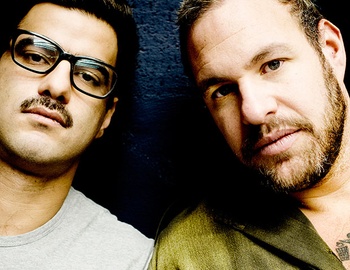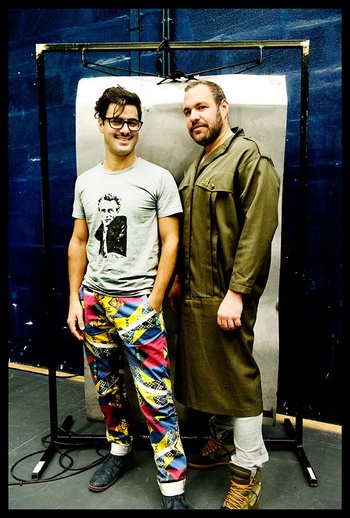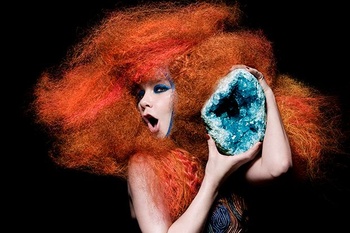(© Saskia Vanderstichele)
“You won’t understand what’s happening: you will feel what’s happening.” The Israeli director Sjaron Minailo and the Lebanese-born conductor Bassem Akiki have joined forces for an operatic adaptation of Björk’s album Medúlla. A kind of ritual takes place onstage that touches the very essence of humanity in the universal language of music.
In August 2004, the Icelandic singer Björk brought out Medúlla, an album that sought – in reaction to the racist and neo-nationalist excesses provoked by the attacks of 11 September 2001 – the “core” (medulla) of humanity that we all share. Featuring choirs, traditional Inuit throat singing, and human beatboxing, Medúlla explored all the possibilities of the human voice. The album, more topical today than ever, is now taking on a new life as an opera. The production is the work of a highly symbolic duo: the Dutch-based Israeli director Sjaron Minailo and the Polish-based Lebanese conductor Bassem Akiki.
Whose idea was this project?
Sjaron Minailo: I came up with the idea, together with Krystian Lada, a dramaturge at De Munt/La Monnaie. I know this album from when it came out in 2004. It was very inspiring for me because of this beautiful combination of different styles of music and the complete reliance on the human voice. Back in 2005, we made an opera film with Anat Spiegel, who has rearranged Björk’s album as an opera and also wrote new pieces for this production. Musically, we were very much inspired by Medúlla. Since then, I always dreamed of translating it into opera and now, ten years later, it is actually happening. It’s especially topical now, with what has been going on recently in Brussels and Paris.
Did Björk impose certain requirements when it came to adapting her album?
Minailo: The only thing she asked was that we wouldn’t turn it into completely classical music. For her, it is important that it is a combination of all vocal styles and musical styles. That is something that Anat managed to keep very much in the score and that’s something that Bassem is now working very hard and very well on, with singers who are classically trained. They are trying to see how they can transcend their technique.
Bassem Akiki: It’s a matter of finding colours. The piece is quite easy and simple in a way, but the simplicity starts to be a little bit more complex when each line is sung in a different way. You have to find a different colour for each word, for each note. It’s a process we are working on with Anat and the singers. We try to create a lot of contrast. That’s what it is about in every kind of music: contrast. It’s a bit of a coincidence, but before this project, in November, I had Beth Gibbons from Portishead singing classical music in Górecki’s Third Symphony and now we have classical singers singing Björk. It’s bringing two worlds together but it is still music and music is one.
In what way is Medúlla an opera?
Minailo: It’s an opera in every way. Opera is either a style or a form. And for me, if we speak about opera as a form, it is musical drama. That is how Monteverdi or, later, Wagner defined it. It is all about drama told by music. Everything is secondary to the music. The main tool for telling the drama is the music. The text is secondary to it; the staging is secondary to it. The music is the driving force, the engine that moves everything.
Medúlla: Björk translated into opera


Is the album recognisable? Did you follow its sequence?
Minailo: The first thing we did to translate Medúlla into opera was to make a selection of songs. We don’t use all the songs. For example, I left “Oceania” out: it’s a great song, but for me it didn’t fit the idea. What she does with the voice in it is the most “pop song-like”, for me. Then we reorganised the songs and we used some as motifs that are repeated. That way, the source material can grow and explore territories other than those on the album.
Akiki: One of the motifs, for example, is “Pleasure Is All Mine”, which is sung many times, but each time it comes back differently and it means something different. Which is why the album is a little over 45 minutes, but the opera lasts about an hour and a half. Repetition is a fundamental principle in music, in every genre of music.
You also added two new songs.
Minailo: Yes, Anat added two new songs. She chose to work on a text by E.E. Cummings, a poet Björk also used on her album [in particular, “Sun in My Mouth” on Vespertine and “Sonnets/Unrealities XI” on Medúlla – ES].
Does the opera tell a story?
Minailo: There is a story, but there is no plot. It’s a situation. Onstage, there is a community, a civilisation that is trying to react to a tragic situation. As the director, I don’t focus on telling “a plot”: I’m much more focused on translating the music. So you could see it much more as dance, in the sense that when you see a dance performance, of course there is always a sense of a story but it’s more about music, movement, etc. There is a story because you need a framework, but we don’t illustrate the story. We try to bring it to life so that the audience can actually start to see the music, listening with their eyes instead of only with their ears.
The performers onstage include De Munt/La Monnaie’s Children’s and Youth choirs. Why did you choose them?
Minailo: The children were the starting point. Onstage, we have a chorus of children and we have solo singers who are over 55. I made that choice because I often work with older singers and performers and I find that they have a great presence onstage. They have so much experience, I could watch them for hours. Onstage, there is a kind of imaginary society that is made up of two groups: children and older adults. The generation between those two groups, our generation, is gone. That’s the situation. In the Dutch language, over the last four or five years, the word “top” has come to be overused : “top artist”, “top scientist”, “top director”, and so on. There is a sort of obsession with that. Those people at the top are always around forty years of age. I’m much more interested in the people who are before or after “the top”. I want to distance myself from the “athletic” approach we have today in our society. Our singers may not be the greatest virtuosos any more, but they are great performers who offer something onstage that goes beyond what being athletic can offer.
You are an artistic duo with a considerable symbolic content: an artist from Lebanon and an artist from Israel. What brought you together?
Akiki: It was De Munt/La Monnaie who asked me to work on this project. I grew up with the classical repertoire and I adore the operas of Verdi, Puccini, and so on...but we cannot stop here. Some people think opera is dead, but I don’t agree. I think that our generation is the one that is going to do away with that kind of thinking, that will give a new spirit to opera. I was talking to Krystian Lada about that and he brought up the Medúlla project. That’s how I met Sjaron and we immediately found a common language.
Minailo: Bassem comes from Lebanon; I come from Israel, Anat too; Henry Vega, who does the electronics, comes from America; Henrik Vibskov, who does the sets and scenery, is Danish... We all come from different places. We were born somewhere and we chose to leave the country we grew up in and to study or start a career somewhere else – and that’s part of the globalised world we live in. But globalisation has also led to the xenophobia we have today. We celebrate globalisation by working on this project together, but at the same time globalisation also gave birth to this state of uncertainty. All these things are connected.
Medúlla is about the universality of music. It’s a celebration of universalism, but we are all very much aware that this universalism is also something that a lot of people are afraid of. In that context, some people choose to withdraw into themselves, to something that is “safe”. Lots of people say, “It’s tradition and if it’s tradition, it’s good”. We hold on to that tradition and we don’t let it go. The community presented in Medúlla reacts exactly like that. Relying on their traditions also brings about their downfall. We are aware of those fears, but we are just trying to say here that there are other options.
AND YET MORE BJÖRK...
Already in the international limelight with the release – brought forward – of her album Vulnicura, Björk is going to be really omnipresent in Brussels over the next few days. Next to the premiere at De Munt/La Monnaie of the opera Medúlla, based on her 2004 album of the same name, the Galeries cinema is organising a mini-festival with films and videos featuring the colourful Icelandic artist.
Minailo: The first thing we did to translate Medúlla into opera was to make a selection of songs. We don’t use all the songs. For example, I left “Oceania” out: it’s a great song, but for me it didn’t fit the idea. What she does with the voice in it is the most “pop song-like”, for me. Then we reorganised the songs and we used some as motifs that are repeated. That way, the source material can grow and explore territories other than those on the album.
Akiki: One of the motifs, for example, is “Pleasure Is All Mine”, which is sung many times, but each time it comes back differently and it means something different. Which is why the album is a little over 45 minutes, but the opera lasts about an hour and a half. Repetition is a fundamental principle in music, in every genre of music.
You also added two new songs.
Minailo: Yes, Anat added two new songs. She chose to work on a text by E.E. Cummings, a poet Björk also used on her album [in particular, “Sun in My Mouth” on Vespertine and “Sonnets/Unrealities XI” on Medúlla – ES].
Does the opera tell a story?
Minailo: There is a story, but there is no plot. It’s a situation. Onstage, there is a community, a civilisation that is trying to react to a tragic situation. As the director, I don’t focus on telling “a plot”: I’m much more focused on translating the music. So you could see it much more as dance, in the sense that when you see a dance performance, of course there is always a sense of a story but it’s more about music, movement, etc. There is a story because you need a framework, but we don’t illustrate the story. We try to bring it to life so that the audience can actually start to see the music, listening with their eyes instead of only with their ears.
The performers onstage include De Munt/La Monnaie’s Children’s and Youth choirs. Why did you choose them?
Minailo: The children were the starting point. Onstage, we have a chorus of children and we have solo singers who are over 55. I made that choice because I often work with older singers and performers and I find that they have a great presence onstage. They have so much experience, I could watch them for hours. Onstage, there is a kind of imaginary society that is made up of two groups: children and older adults. The generation between those two groups, our generation, is gone. That’s the situation. In the Dutch language, over the last four or five years, the word “top” has come to be overused : “top artist”, “top scientist”, “top director”, and so on. There is a sort of obsession with that. Those people at the top are always around forty years of age. I’m much more interested in the people who are before or after “the top”. I want to distance myself from the “athletic” approach we have today in our society. Our singers may not be the greatest virtuosos any more, but they are great performers who offer something onstage that goes beyond what being athletic can offer.
You are an artistic duo with a considerable symbolic content: an artist from Lebanon and an artist from Israel. What brought you together?
Akiki: It was De Munt/La Monnaie who asked me to work on this project. I grew up with the classical repertoire and I adore the operas of Verdi, Puccini, and so on...but we cannot stop here. Some people think opera is dead, but I don’t agree. I think that our generation is the one that is going to do away with that kind of thinking, that will give a new spirit to opera. I was talking to Krystian Lada about that and he brought up the Medúlla project. That’s how I met Sjaron and we immediately found a common language.
Minailo: Bassem comes from Lebanon; I come from Israel, Anat too; Henry Vega, who does the electronics, comes from America; Henrik Vibskov, who does the sets and scenery, is Danish... We all come from different places. We were born somewhere and we chose to leave the country we grew up in and to study or start a career somewhere else – and that’s part of the globalised world we live in. But globalisation has also led to the xenophobia we have today. We celebrate globalisation by working on this project together, but at the same time globalisation also gave birth to this state of uncertainty. All these things are connected.
Medúlla is about the universality of music. It’s a celebration of universalism, but we are all very much aware that this universalism is also something that a lot of people are afraid of. In that context, some people choose to withdraw into themselves, to something that is “safe”. Lots of people say, “It’s tradition and if it’s tradition, it’s good”. We hold on to that tradition and we don’t let it go. The community presented in Medúlla reacts exactly like that. Relying on their traditions also brings about their downfall. We are aware of those fears, but we are just trying to say here that there are other options.
AND YET MORE BJÖRK...
Already in the international limelight with the release – brought forward – of her album Vulnicura, Björk is going to be really omnipresent in Brussels over the next few days. Next to the premiere at De Munt/La Monnaie of the opera Medúlla, based on her 2004 album of the same name, the Galeries cinema is organising a mini-festival with films and videos featuring the colourful Icelandic artist.

(© Inez & Vinoodh - Courtesy of Wellhart One Little Indian)
You will have a chance to see, for example, Drawing Restraint 9 (1 Feb., 8 pm), which was screened in the out-of-competition section of the Venice Film Festival in 2005. In the film, directed by Björk’s ex, the US visual artist Matthew Barney (The Cremaster Cycle), she appears alongside him; she also did the soundtrack music. Barney’s film is set in Japan, in Nagasaki Bay, where a whaling ship on which two Westerners are guests is caught up in a storm. Peter Strickland and Nick Fenton’s Biophilia Live (2 Feb., 8 pm) used 16 cameras to film the 360-degree concert given by Björk and her group in 2013 at Alexandra Palace in London. On Saturday 7 February, on the eve of the final performance of Medúlla, the cinema presents a “Björk Night”, focusing on Björk’s videos, which are always very interesting visually and on which she has often collaborated with the French director Michel Gondry – amongst others video clips for “Human Behaviour”, “Army of Me”, “Isobel”, “Hyperballad”, “Jóga”, and “Bachelorette”).
Photos © Saskia Vanderstichele
MEDÚLLA • 4/2, 19.30, 7/2, 15 & 19.30, 8/2, 15.00, €20/40, De Munt/La Monnaie (zaal/salle Malibran), Munt/place de la Monnaie, Brussel/Bruxelles, 070-23.39.39, www.demunt.be, www.lamonnaie.be
You will have a chance to see, for example, Drawing Restraint 9 (1 Feb., 8 pm), which was screened in the out-of-competition section of the Venice Film Festival in 2005. In the film, directed by Björk’s ex, the US visual artist Matthew Barney (The Cremaster Cycle), she appears alongside him; she also did the soundtrack music. Barney’s film is set in Japan, in Nagasaki Bay, where a whaling ship on which two Westerners are guests is caught up in a storm. Peter Strickland and Nick Fenton’s Biophilia Live (2 Feb., 8 pm) used 16 cameras to film the 360-degree concert given by Björk and her group in 2013 at Alexandra Palace in London. On Saturday 7 February, on the eve of the final performance of Medúlla, the cinema presents a “Björk Night”, focusing on Björk’s videos, which are always very interesting visually and on which she has often collaborated with the French director Michel Gondry – amongst others video clips for “Human Behaviour”, “Army of Me”, “Isobel”, “Hyperballad”, “Jóga”, and “Bachelorette”).
Photos © Saskia Vanderstichele
MEDÚLLA • 4/2, 19.30, 7/2, 15 & 19.30, 8/2, 15.00, €20/40, De Munt/La Monnaie (zaal/salle Malibran), Munt/place de la Monnaie, Brussel/Bruxelles, 070-23.39.39, www.demunt.be, www.lamonnaie.be
Read more about: Muziek
Fijn dat je wil reageren. Wie reageert, gaat akkoord met onze huisregels. Hoe reageren via Disqus? Een woordje uitleg.